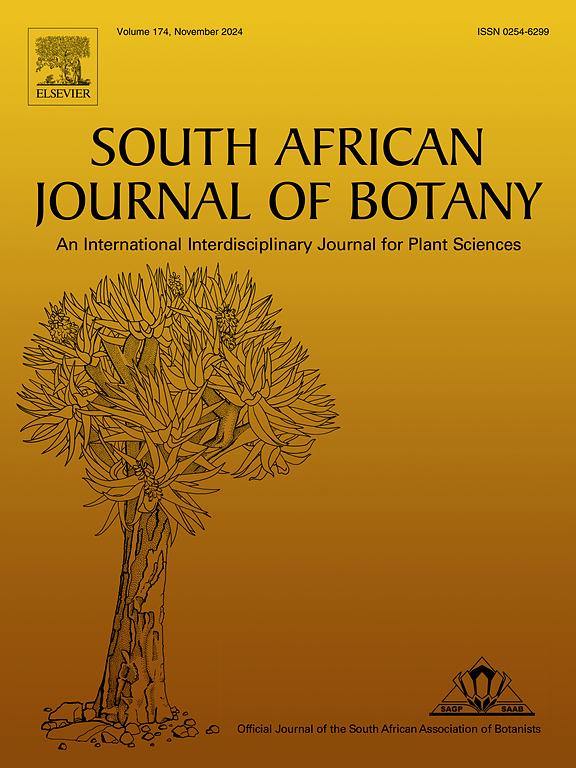A review of documented antimicrobial and immunomodulatory properties of six selected ethnomedicinal plants, used as a concoction by traditional health practitioners for the management of urinary tract infections, in the region of KwaZulu-Natal, South Africa
IF 2.7
3区 生物学
Q2 PLANT SCIENCES
引用次数: 0
Abstract
Urinary tract infections (UTIs) are among the most common bacterial infections across the globe, indicated by significant bacterial growth and presence of microbial pathogens anywhere along the urinary tract with associated symptoms. Due to the alarming global increase of antibiotic-resistant bacteria resulting in antibiotic therapy failures, a need for new ethnobotanical species has redirected research towards assessing locally available medicinal plants and their respective crude extracts which contain novel bioactive derivatives. The World Health Organization (WHO) has rendered traditional medicine as a safe and effective alternative for treating various illnesses and infections based on the scientific evidence that these medicinal plants are scientifically tested for efficacy and adverse side-effects through rigorous research, testing and clinical trials. South African traditional health practitioners (THPs) in the eThekwini Municipality promote the use of Euclea crispa, Curtisia dentata, Manihot esculenta, Bulbine natalensis, Catha edulis and Eucomis bicolor as single preparations with antimicrobial, anti-inflammatory, analgesic, wound healing, and immunomodulatory properties in the treatment of various illnesses and together as a traditional concoction towards the treatment of UTIs. Literature reviewed in this article, reflects the presence of triterpenoids, oleanolic acid, tannins, flavonoids, alkaloids, anthocyanosides, bulbnatalonosides, sterols, homoisoflavonoids, saponins, cyclooxygenases within these ethnomedicinal species and their action against uropathogenic E. coli (UPEC), K. pneumoniae, E. faecalis, P. aeruginosa, S. aureus and C. albicans. Hence these six South African medicinal plants can be considered as strong contenders against microbial-induced UTIs.
对南非夸祖鲁-纳塔尔地区传统医疗从业者用于治疗尿路感染的六种精选民族药用植物的抗菌和免疫调节特性的文献综述
尿路感染(UTI)是全球最常见的细菌感染之一,表现为细菌大量繁殖、尿路任何部位出现微生物病原体并伴有相关症状。由于全球抗生素耐药菌的增加令人担忧,导致抗生素治疗失败,因此对新的人种植物品种的需求使研究转向评估当地可用的药用植物及其各自的粗提取物,其中含有新型生物活性衍生物。世界卫生组织(WHO)将传统医学视为治疗各种疾病和感染的安全有效的替代疗法,其科学依据是这些药用植物通过严格的研究、测试和临床试验,对其疗效和不良副作用进行了科学检测。南非 eThekwini 市的传统保健医师(THPs)提倡使用 Euclea crispa、Curtisia dentata、Manihot esculenta、Bulbine natalensis、Catha edulis 和 Eucomis bicolor 作为具有抗菌、消炎、镇痛、伤口愈合和免疫调节特性的单一制剂来治疗各种疾病,并将其作为治疗尿毒症的传统药剂。本文所查阅的文献表明,这些民族药用植物中含有三萜类、齐墩果酸、鞣质、黄酮类、生物碱、花青素苷、保泰松苷、甾醇、同异黄酮类、皂苷、环氧化酶,它们对尿路致病性大肠杆菌(UPEC)、肺炎双球菌、粪大肠杆菌、铜绿假单胞菌、金黄色葡萄球菌和白细胞介素有抑制作用。因此,这六种南非药用植物可被视为抗微生物引起的尿道炎的有力竞争者。
本文章由计算机程序翻译,如有差异,请以英文原文为准。
求助全文
约1分钟内获得全文
求助全文
来源期刊

South African Journal of Botany
生物-植物科学
CiteScore
5.20
自引率
9.70%
发文量
709
审稿时长
61 days
期刊介绍:
The South African Journal of Botany publishes original papers that deal with the classification, biodiversity, morphology, physiology, molecular biology, ecology, biotechnology, ethnobotany and other botanically related aspects of species that are of importance to southern Africa. Manuscripts dealing with significant new findings on other species of the world and general botanical principles will also be considered and are encouraged.
 求助内容:
求助内容: 应助结果提醒方式:
应助结果提醒方式:


